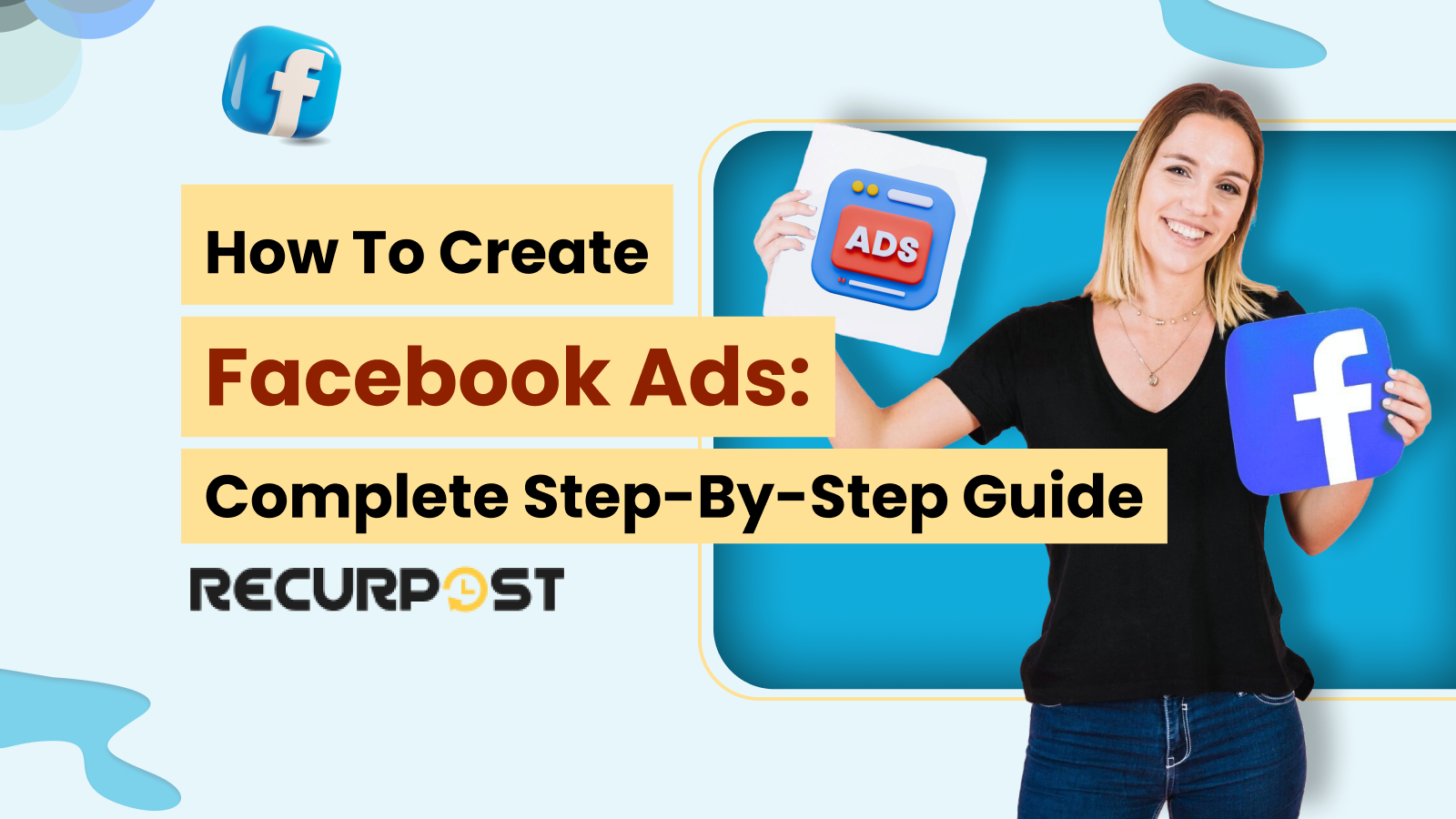Ready to create Facebook ads in 2025?
You’re tapping into Meta’s massive audience: over 2.9 billion monthly active users. With Facebook ads, your message appears where people spend time on feeds, Stories, Reels, Messenger, and Instagram.
Meta’s ad system lets you promote products, build brand awareness, and drive website traffic using targeted campaigns. You can use formats like carousel ads, video ads, story ads, and lead ads, each designed for action and high visibility.
This guide shares a step-by-step process to create Facebook ads that attract, engage, and convert your best audience.
What Are Facebook Ads?
Facebook ads are paid promotions designed to reach people based on their interests, online activity, and demographics across Meta platforms: Facebook, Instagram, Messenger, and Audience Network. The Facebook ad system uses data from apps, websites, and user profiles to deliver personalized ads directly inside feeds, stories, and even in Messenger or Instagram.
With Facebook advertising, you can promote products, launch mobile apps, fill event registrations, or grow any service. These ads allow you to create many campaigns, set a daily or lifetime budget, and select who sees your message using detailed audience targeting.
Facebook ads outperform regular posts by pushing your message past shrinking organic reach to deliver more clicks, quality leads, and direct sales.
Facebook Ad Formats
Choosing the right Facebook ad format shapes how your campaign performs. Each ad format is designed for a different goal, like boosting clicks, building interest, or driving conversions. You’ll create and manage every ad type in Facebook Ads Manager, which runs campaigns on Facebook, Instagram, Messenger, and the Audience Network.
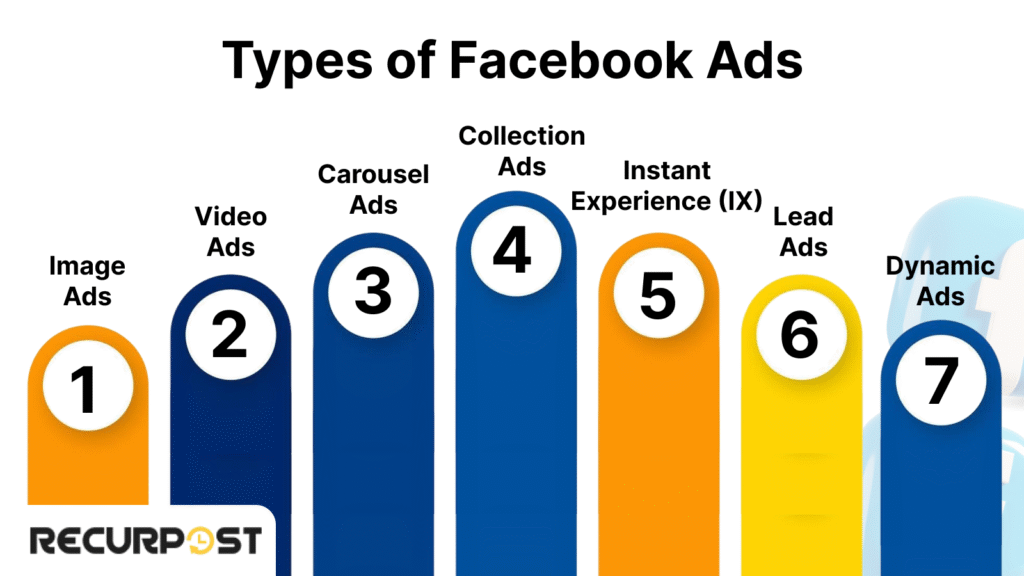
1. Facebook Image Ads
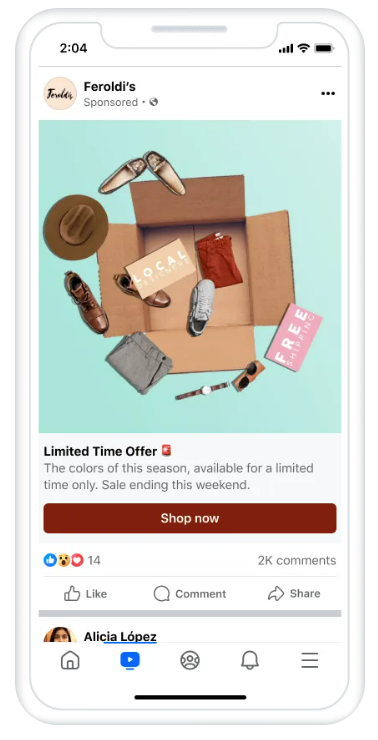
Ideal for simple promotions or straightforward brand messages.
- Use a lucrative background image that grabs attention fast.
- Keep text minimal and readable on both desktop and Facebook on this browser.
- Great for sharing quick updates, sales, or launching a new account.
Stock images or professionally designed templates work well when you lack custom visuals.
2. Facebook Video Ads
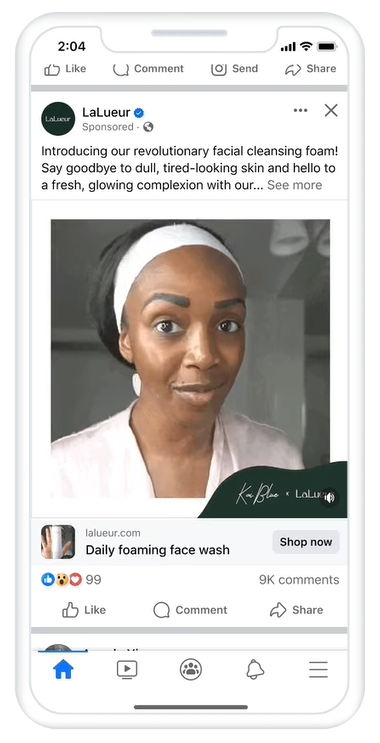
Video content increases engagement.
- Best for Facebook advertisement campaigns that tell a story, show results, or explain a service.
- Ideal length: under 15 seconds.
- Add captions, and many watch videos on social platforms with the sound off.
3. Facebook Carousel Ads
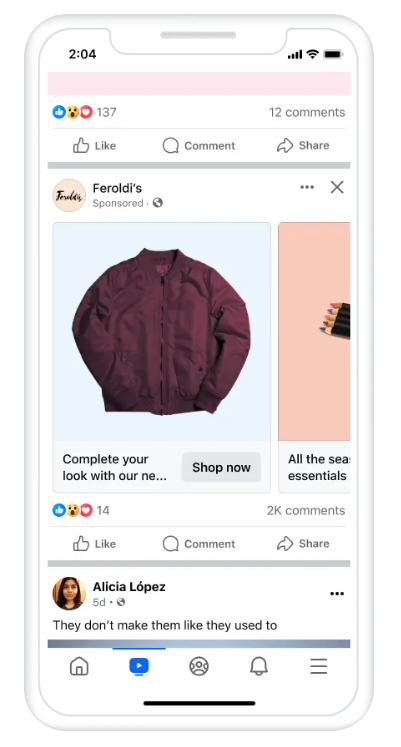
Displays multiple items or steps in a swipeable format.
- Useful for highlighting product ranges, comparing features, or tutorials.
- Each card can link to a different landing page.
- Works well in both feed and Facebook story ads.
Ideal for e-commerce businesses showcasing multiple products in one ad.
4. Facebook Collection Ads
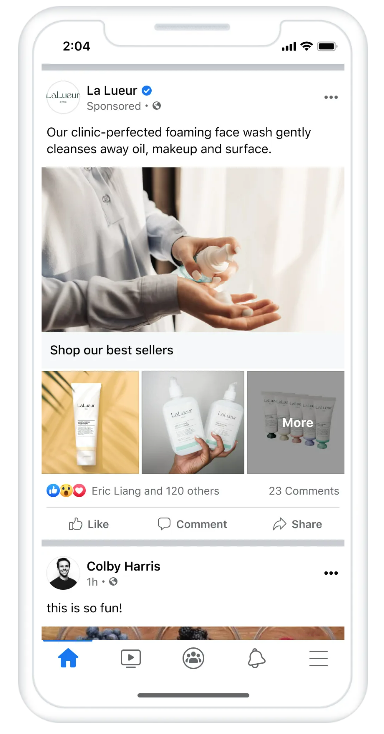
Features one lead visual with a grid of related items.
- Designed for mobile-first browsing.
- Pulls from your product catalog to personalize the experience.
- Enhances your ad experience in accounts where mobile speed matters.
5. Facebook Instant Experience
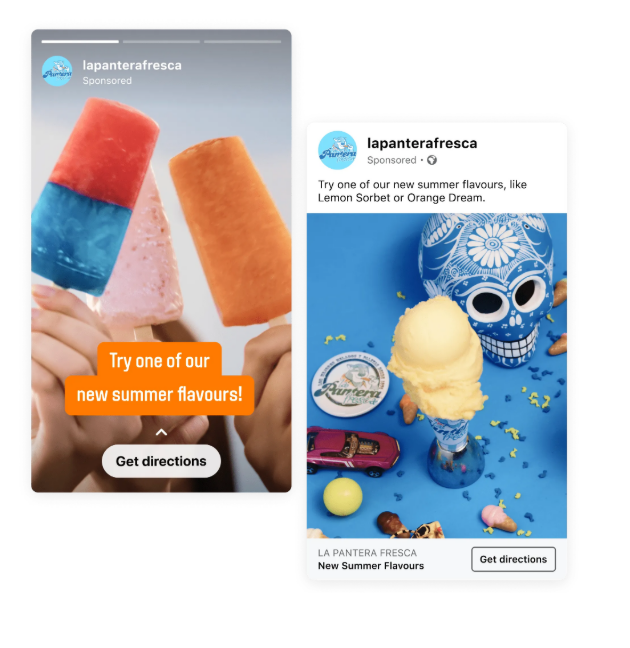
Full-screen, fast-loading mobile ads.
- Ideal for storytelling, product launches, or sign-up flows.
- Supports videos, carousels, forms, and features like maps, payment services, and video.
- Features like maps, payment services, embedded videos, and swipe-ups make it immersive.
Cookies and similar technologies help provide features like maps, payment services, and video within Instant Experience ads.
Real-Life Examples of Instant Experience Formats to Deliver High Visual Impacts
6. Facebook Lead Ads
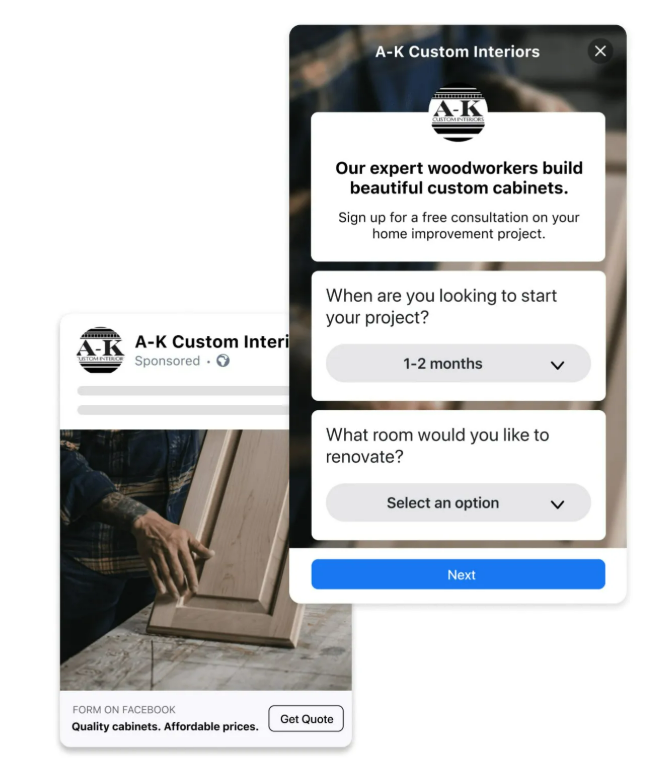
Collects leads without redirecting users off-site.
- Use pre-filled forms with name, mobile number, or email.
- Shorten the path from interest to action.
- Helps collect data while respecting cookies by Facebook and privacy tools.
7. Facebook Dynamic Ads
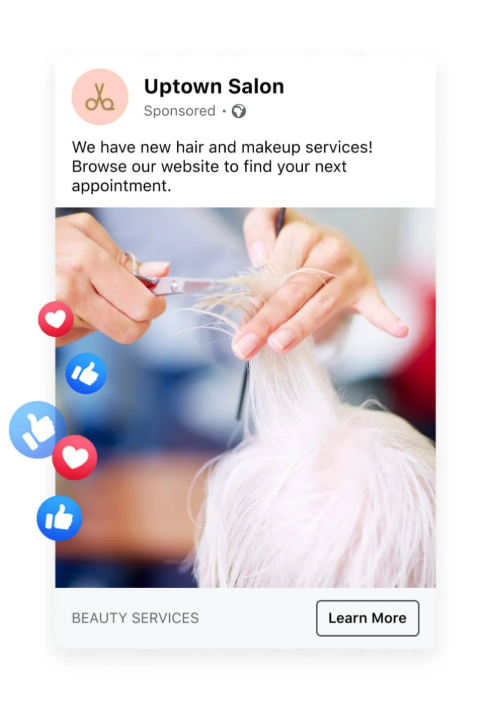
Personalized ads based on browsing behavior.
- Great for retargeting visitors with products they’ve viewed.
- Needs product catalog + pixel set up in Facebook Ads Manager.
- Adapts to behavior across websites and apps, even when users decline optional cookies.
Users have control over the optional cookies we use and can use them and review or change their preferences at any time, including within Facebook’s ad personalization and privacy settings.
These ads use cookies to show relevant content while respecting browser settings and ad preferences.
Facebook Ads Guide to Learn about Different Formats of Facebook Ads
How to Create Facebook Ads
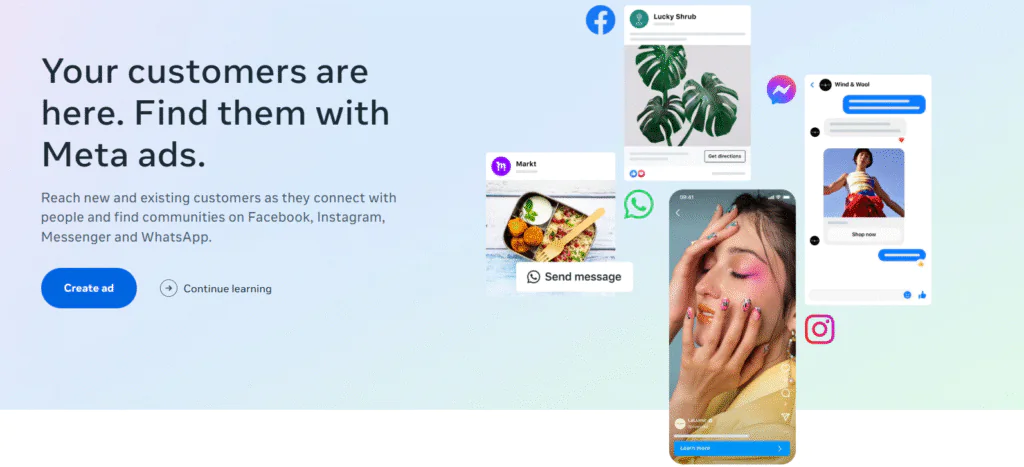
Creating Facebook ads is easy when you follow these steps: set up Facebook Business Manager, define your campaign objective, target your audience, design creatives, and launch everything in Facebook Ads Manager.
A. Set Up for Success
Start by creating your Facebook Business Manager and Ad Account. This dashboard keeps all your ads, permissions, billing, and assets organized in one place.
1. Set Up Your Facebook Business Manager
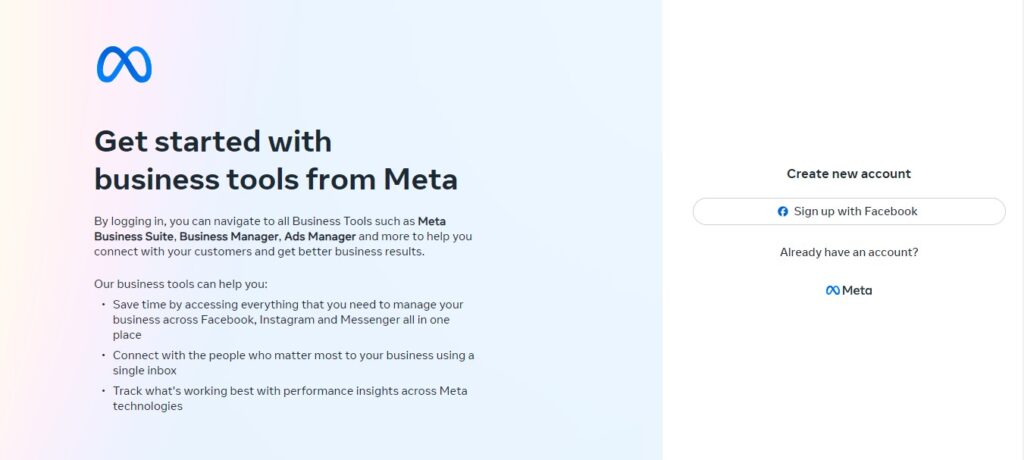
Business Manager structures and secures your workflow when managing multiple pages or campaigns.
- Go to business.facebook.com and create a new account.
- Link your Facebook Page and advertising account.
- Assign team roles: admin, analyst, or advertiser.
- Add your Meta Pixel for tracking visits, signups, or sales.
- Store logos, images, or Facebook ad templates to use later.

Tip: Install Meta Pixel before starting ads to collect audience data from day one.
2. Set Up Your Ad Account
Ad Accounts house your campaigns and manage delivery, spending, and reporting for all Facebook advertisements.
- Choose your country, currency, and time zone.
- Add a payment method (credit card, PayPal, etc).
- Double-check all business details and link only business pages.
- Keep business and personal activities separate.
- Adjust notification settings for better management.
After setup, launch ads in Facebook Ads Manager and monitor performance across all campaigns.
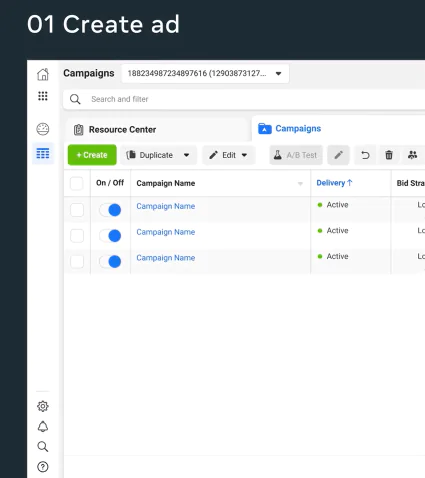
B. Build & Launch Your Facebook Ad Campaign
Creating an advertisement on Facebook involves accessing Facebook Ads Manager, where you define your campaign objective, select your target audience, set your budget and schedule, choose ad placements, and design your creative content before submitting it for review.
1. Set Your Campaign Objective
Every ad begins with defining what action you want people to take. Pick a campaign goal in Facebook Ads Manager:
- Awareness: Reach more users and build brand awareness.
Best for brand awareness campaigns and early-stage businesses.
- Consideration: Drive clicks, video views, or messages.
Ideal for lead collection, interest generation, and content promotion.
- Conversion: Motivate purchases or sign-ups.
Select this objective when scaling campaigns and driving measurable results.
Choose what fits your business best. This setting shapes how Facebook ads are delivered.
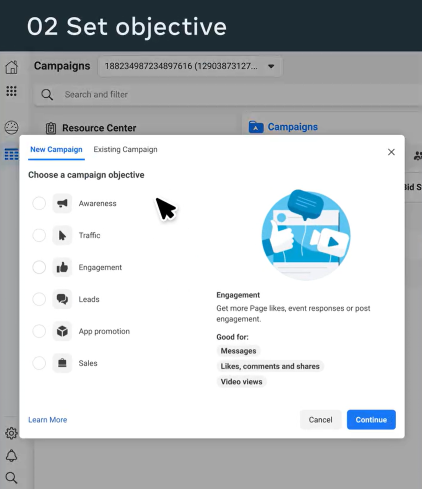
2. Target Your Audience
Facebook marketing ads require following best practices that include proper audience targeting through Core Audiences for demographic filtering, Custom Audiences for reconnecting with past visitors, and Lookalike Audiences for reaching new people who behave like your best customers.
Pick from three types in Ads Manager:
- Core Audiences: Filter by age, location, interests, behaviors, or jobs.
- Custom Audiences: Reconnect with past website visitors, app users, or Facebook page fans.
- Lookalike Audiences: Find new users who act like your best customers.
Not too narrow, not too broad, adjust until you get the best reach and results.
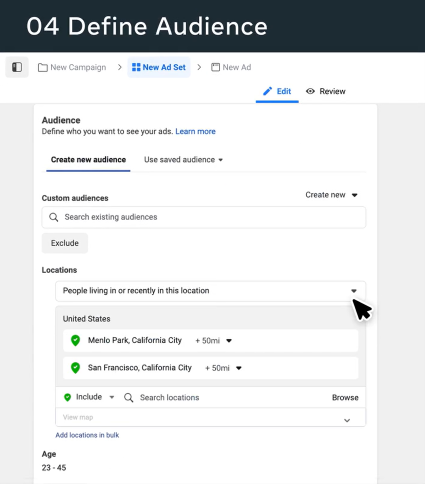
3. Set Budget and Schedule
In Ads Manager, set your spending and scheduling parameters at the ad set level:
- Daily Budget: Your ad spend per day.
- Lifetime Budget: Total spending across the entire campaign(Spend for the entire campaign).
- Schedule: Run continuously or pick start and end dates. Pick start/end dates or run all the time.
- Bidding: Use automatic bids or set manual limits for tighter control.
Configuring your budget and schedule at the ad set level allows you to organize and control spending, timing, and targeting for each group of ads within your campaign. Start small, review often, and scale your Facebook ads as you see results.
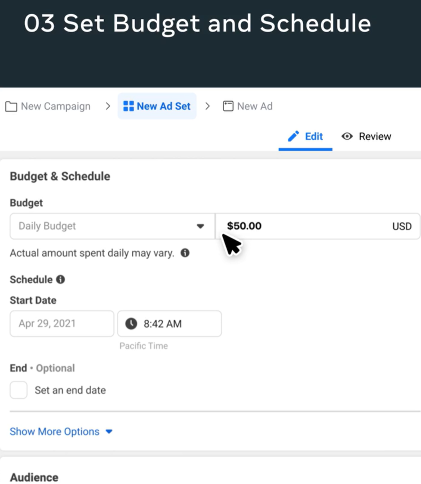
4. Pick Ad Placements
Facebook offers two options for ad placement:
- Automatic Placements (Recommended): Facebook shows your ads where they work best (feeds, Stories, Instagram, Messenger, etc).
- Manual Placements: Pick exactly where you want ads to appear. For best results, use images sized for mobile (1080×1080 pixels) and headlines that are clear on any device.
You can manage your ad experience by visiting the following settings to adjust your ad preferences and placements, ensuring you see ads that are most relevant to you.
Since most users browse on mobile, ensure your visuals (especially background images, headlines, and CTAs) are sized and styled for smaller screens.
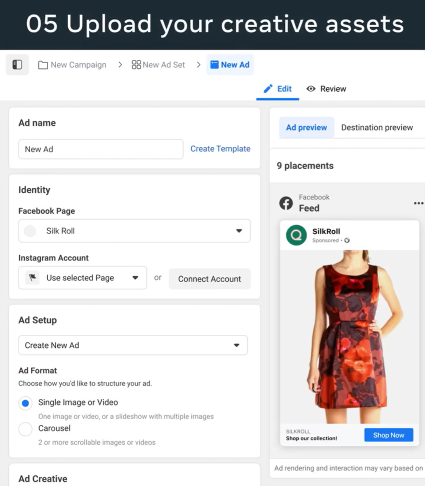

Tip: Use Meta’s specs and fast-loading creative to avoid delivery problems.
C. Create Your Ad Creative
Designing effective Facebook ads requires creating cohesive ad creative that combines attention-grabbing visuals sized at 1080 × 1080 pixels, concise action-oriented copy under 125 characters, and clear call-to-action buttons that align with your campaign objectives and landing page experience.
1. Pick the Right Format
Ads Manager offers several formats to connect with your audience:
- Single Image: Sharp, direct, and easy to understand.
- Video: Great for storytelling, demos, or behind-the-scenes content.
- Carousel: Swipeable cards, perfect for multiple products or process steps.
- Collection: Combines a cover image or video with a product grid, ideal for mobile shopping.
If you’re short on visuals, use Facebook advertisement templates or stock images to keep things professional.
2. Write Clickable Copy
Copy is as important as visuals. Keep your ad text short, clean, and action-oriented:
- Primary Text: Aim for 125 characters or fewer, what people see first.
- Headline: Bold, benefit-focused, and under 40 characters.
- Description: Adds urgency or extra info (30 characters or less).
Attention-grabbing Facebook ads communicate more with fewer words.
3. Choose a CTA Button
Select a call-to-action button that aligns with your goal to increase clicks:
- Shop Now
- Learn More
- Sign Up
- Send Message
Align ad actions with landing pages: consistency builds trust and improves user experience.
4. Use Media Specs That Work
Ensure your creative looks good on both desktop and mobile.
- Images: 1080 × 1080 pixels (square works best across devices).
- Videos: MP4 or MOV, under 15 seconds.
- Add subtitles: Most people watch videos on Meta products without sound.
- Avoid too much text on visuals: Facebook ads with overloaded graphics may be shown less often.
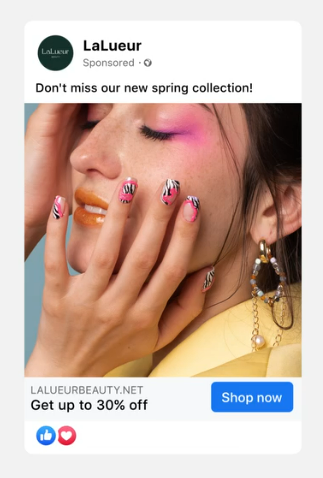
Use professional templates with clean designs. Optimized ads load faster and perform better on slower connections and older devices.
D. Launch and Go Live
After finalizing your creative, launch your Facebook ad campaign with these final steps.
1. Final Checklist Before Launch
Before launching Facebook ads, confirm all elements of your setup align:
✅ Campaign objective fits your marketing goal.
✅ The target audience is clearly defined.
✅ Budget and schedule are locked in.
✅ Ad formats match the creative concept.
✅ CTA connects with your landing page.
✅ Visuals follow Facebook’s ad specs for clarity and reach.
✅ Placements are mobile-optimized for better performance.
Preview your ad across feeds, Stories, and other placements on desktop and mobile using Ads Manager.
2. Submit for Review
Facebook reviews all ads before they go live to ensure they follow platform rules.
- Checks include: image quality, text, links, and policy alignment.
- Reviews are usually complete within 24 hours; timing may vary.
- You’ll get a notification once your ad is approved and active.
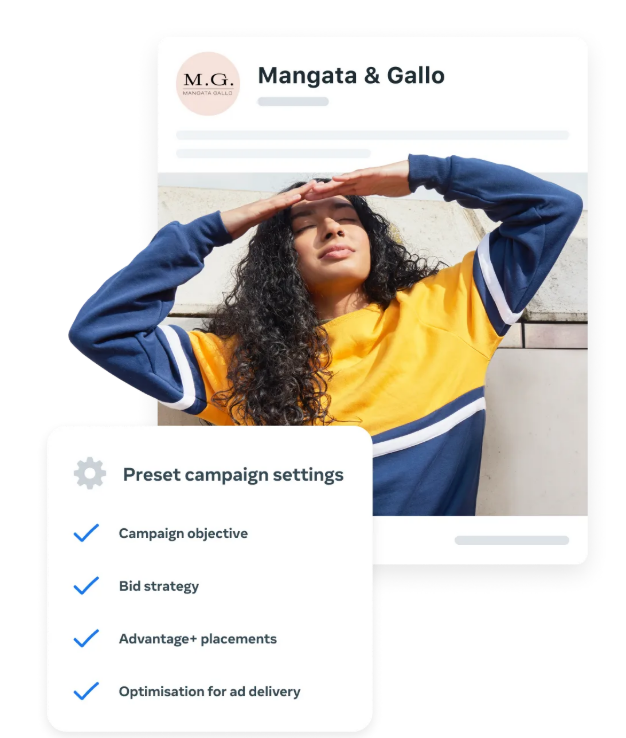
What to Do If Your Ad Gets Rejected
If your Facebook ad is rejected, don’t start from scratch. Fix the issue and resubmit. Here’s what to do:
- Open Facebook Ads Manager and review the rejection reason.
- Edit the flagged part: This could be your ad copy, image, or even a detail on your landing page.
- Resubmit your ad for approval through Ads Manager.
- Make sure your ad follows Meta’s advertising policies, especially for sensitive topics like health, finance, or personal services.
Sticking to the rules helps keep your Facebook ads running smoothly and avoids campaign delayealth, finance, or personal services, to prevent rejections and maintain smooth campaign delivery.
Monitor and Optimize Performance
Managing a Facebook advertising campaign means checking key metrics in Ads Manager and making small changes for better results. Strong Facebook ads need ongoing tweaks to stay profitable.
Control your ad performance and privacy by updating your ad settings and managing your personal information in Meta’s platform.
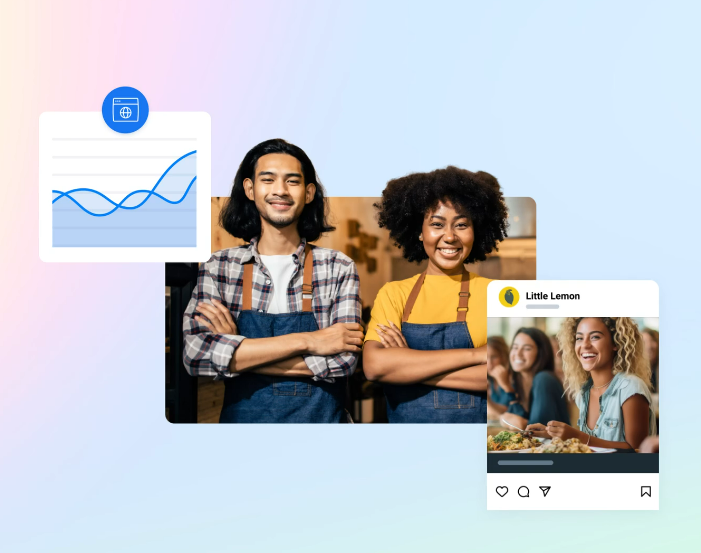
Key Metrics to Watch
Check your campaign data in Facebook Ads Manager every day. Focus on these numbers:
- Reach: How many unique people saw your ad?
- Impressions: Total times your ad appeared.
- CTR (Click-Through Rate): How often users clicked after seeing your ad.
- CPC (Cost Per Click): Average spent per click.
- ROAS (Return on Ad Spend): Revenue made compared to your ad spend.
- Conversions: Key actions like leads, purchases, or downloads.
Use these metrics to guide quick adjustments to your targeting, creative, and budget.
Export Facebook Ads Data to Excel
For deeper analysis, export your Facebook ads data straight to Excel:
- Open Ads Manager and go to your campaign reports.
- Click the Export button at the top right.
- Select Export Table Data and choose Excel (.xlsx).
- Customize the date range and metrics.
- Use Excel’s pivot tables or charts to create custom dashboards.
- Schedule automatic reports to save time and track trends.
Exporting lets you combine Facebook ads data with other channels for advanced analysis and executive reports.
What to Adjust Based on Performance
Use these tips to improve your live Facebook ads:
- Low CTR: Test a new headline, stronger CTA, or different ad format.
- High CPC: Tighten your audience or switch to automatic bidding.
- Low ROAS: Check your offer and landing page for clarity.
- Ad fatigue: Refresh visuals every 7–10 days for fresh, high-performing Facebook ads.
A/B Test Frequently
Run A/B tests to see what works best:
- Swap headlines and CTAs.
- Test new images or videos.
- Try different audience segments.
- Experiment with new placements on Meta’s network.
Apply your test results to make every Facebook ad campaign stronger and smarter.
Advanced Strategies for Better Results
Boost your Facebook ads with these advanced strategies to reach more qualified leads and get the most from your budget.
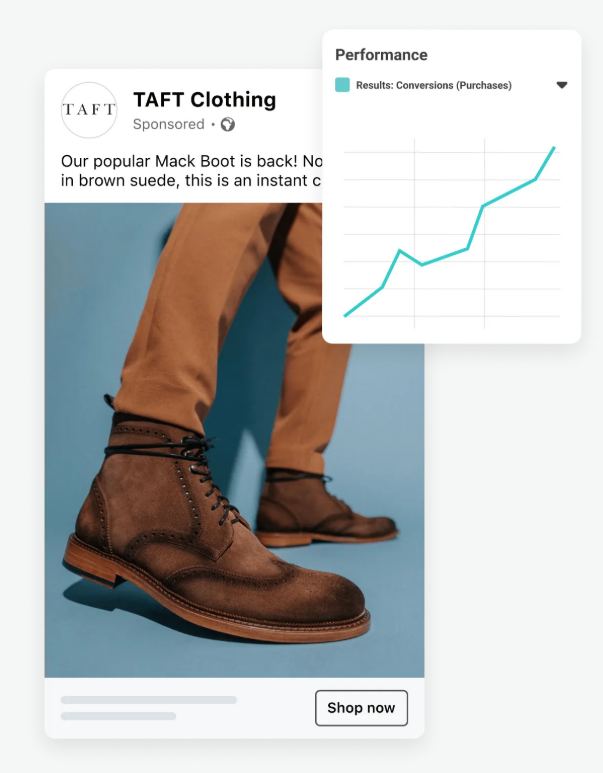
Retarget Past Visitors
Bring back users who already showed interest in your business:
- Show Facebook ads to people who visited your site, watched a video, or clicked a post.
- Perfect for abandoned carts, warm leads, and social media marketing funnels.
- Requires the Facebook Pixel or in-app event tracking to collect behavior data.
- Retargeting increases conversions while lowering costs by avoiding cold audiences.
Scale Using Lookalike Audiences
Find new users who behave like your best customers:
- Upload your source audience: past buyers, newsletter subscribers, or loyal fans.
- Facebook’s system targets people with similar interests, habits, and demographics.
- Lookalike audiences help you grow your reach without sacrificing quality.
- Best when you want to scale beyond your current customer base.
Track Custom Conversions
Measure the actions that matter most, not just clicks:
- Examples: ebook downloads, button clicks, or pricing page visits.
- Set up custom conversions in Events Manager.
- Use this data to better align Facebook ads with real business goals.
- Custom conversion tracking helps you focus ad spend on what drives results.
Use Campaign Budget Optimization (CBO)
Let Facebook automatically spend more on your best-performing ad sets:
- CBO shifts budget in real time to ads that bring the most value.
- Cuts down manual monitoring and helps campaigns targeting several audiences.
- Ideal for large-scale Facebook ad campaigns where budget splitting gets tricky.
Set Automated Rules
Make campaigns smarter with automation:
- Pause underperforming ad sets automatically.
- Increase budget for high-ROAS ads.
- Receive alerts when performance hits your chosen thresholds.
- Set up automated rules in Ads Manager to keep campaigns optimized, even while you focus elsewhere.
Build Excel Dashboards for Campaign Analysis
Track and plan your Facebook ads with advanced Excel tools:
- Export performance data weekly to monitor trends.
- Use Excel templates to auto-calculate ROAS, cost per acquisition, and lifetime value.
- Highlight weak ad sets with conditional formatting.
- Build monthly reports that combine Facebook ad spend and CRM revenue data.
- Forecast future budget needs using past performance with Excel formulas.
Regular Excel analysis reveals trends you might miss in Ads Manager, helping you allocate budget and plan smarter campaigns.
Troubleshooting Facebook Ads
Fixing issues with your Facebook ads quickly helps both beginners and pros save time and budget. Here’s how to handle the most common Facebook advertising problems and keep your campaigns on track:
1. Low Reach
If your Facebook ad isn’t reaching enough people:
- Widen your audience by relaxing detailed filters.
- Raise your daily or lifetime budget in Ads Manager.
- Check your ad placements. Make sure your formats work across all devices.
2. High Costs
If your cost per click (CPC) is too high:
- Refine your targeting to focus on users more likely to take action.
- Try simpler creatives that load faster and send a clearer message.
- Switch to automatic bidding to let Facebook optimize delivery.
3. No Conversions
If people see your Facebook ad but don’t convert:
- Make sure your landing page matches your ad’s promise.
- Optimize your landing page for mobile; slow pages hurt results.
- Use a stronger call-to-action (CTA) so users know the next step.
- Keep your message consistent from ad to landing page.
4. Ad Rejected
If your Facebook ad gets rejected:
- Check Ads Manager for policy violations or flagged content.
- Avoid using language tied to personal attributes.
- Edit the copy, image, or landing page that triggered rejection.
- Resubmit your ad for review.
Knowing and following Meta’s ad policies keeps your Facebook ads live and your campaigns running smoothly.
5. Ad Fatigue
If your Facebook ad performance drops over time:
- Update visuals and try new ad formats every 7–10 days.
- Test fresh copy or rotate different creatives.
- Set frequency caps to avoid showing your ad too often to the same audience.
Fresh content maintains steady results when optimized ads begin to wear out.
How RecurPost Complements Facebook Ads
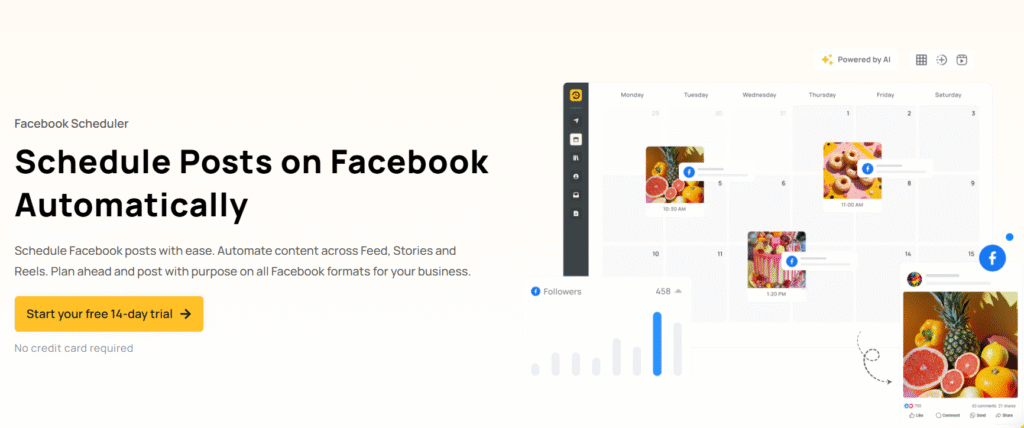
RecurPost makes your Facebook ads stronger by keeping your organic content consistent, on-brand, and perfectly timed alongside paid campaigns.
RecurPost improves your Facebook advertising workflow:
- Schedule organic posts that match your Facebook ads for a seamless brand message.
- Test content performance organically before boosting top posts with Facebook ads.
- Store images, videos, and creatives in organized content libraries for fast reuse.
- Reply to ad comments using RecurPost’s built-in Social Inbox.
- Keep your brand message consistent across Facebook, Instagram, and other social platforms.
- Use AI tools to draft, improve, and repurpose campaign content faster.
This approach lets you manage all your content efficiently, boosting your Facebook ad visibility without extra work. You get the benefits of both paid and organic social media, driving engagement and results.
Conclusion
Winning with Facebook ads means clear goals, the right timing, and sharp targeting, not just spending more. Proper setup in Facebook Ads Manager, strong visuals, and a focused message help turn ad views into clicks, leads, and conversions. When you combine paid campaigns with smart social media marketing, your results keep growing long after your ad is live.
FAQs on Creating Facebook Ads
1. Can I create Facebook ads without linking a personal account?
To create ads on Facebook, you need a Facebook Business Manager account, which must be linked to a verified account for security. However, you can keep business activity separate by creating a new account strictly for business use.
2. How does Facebook use cookies in ad targeting?
Facebook ads rely on cookies and similar technologies to track user behavior across websites and apps. These cookies, both from Facebook and cookies from other companies, show you ads based on your activity, preferences, and interests. Users can adjust preferences in their ad settings or experience in the accounts center.
3. Are there pre-made templates available for Facebook ads?
Yes, you can use Facebook ad templates to speed up the creative process. Many third-party tools and Meta’s own library offer professionally designed templates for different ad formats, including carousel ads, Facebook story ads, and social media ads, to help build eye-catching Facebook ads without hiring a designer.
4. What features should I include in a high-converting Facebook ad?
An effective Facebook ad should include:
– A strong headline
– A relevant background image or video
– Clear CTA (Call-to-Action)
– Consistent messaging
– Targeted placement across social media platforms
Also, ensure it loads fast, is mobile-friendly, and uses optimized ads that don’t rely heavily on text.
5. How do privacy settings affect Facebook ad delivery?
User privacy tools like ad blockers, browser controls, or the option to decline optional cookies can impact how your ads are shown. Facebook adjusts delivery based on who allows these cookies, which is why your ad may not appear consistently across Facebook on this browser or ads off of Meta.

Ruchi Dhimar is a skilled content writer with 5 years of experience. She is passionate about crafting compelling narratives, specializing in writing content for different industries.

